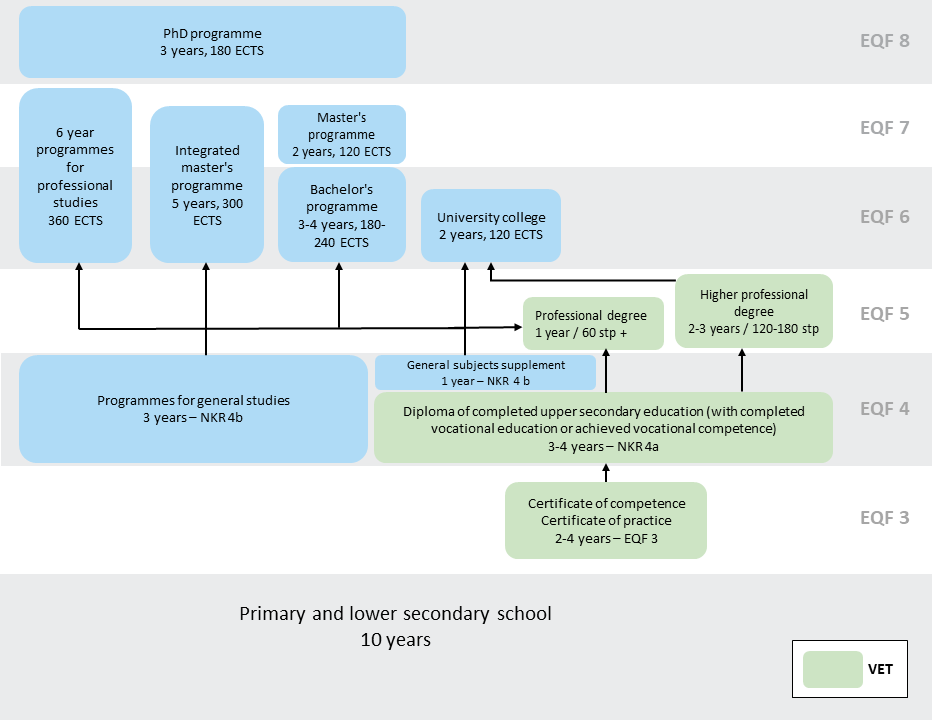1. Diagramme of the Norwegian VET system

NB: The diagramme does not show all qualifications and all connections between programmes.
2. Description of the Norwegian VET system
Vocational training is part of the structure for upper secondary education in Norway. Vocational training in Norway is based on learning in working life and transfer of knowledge from a master to an apprentice. The industry/sector takes a large part of the responsibility for the training and in the vast majority of trades, the vocational training is organised through apprenticeships.
There are 10 vocational programmes. The standard training path is a 2+2 model consisting of a combination of school and company training, where the apprenticeship contract must be agreed with an approved company. The final exam, which is usually a combination of theoretical and practical exercises, leads to a diploma of completion and a trade – or journeyman’s certificate.
Vocational model EQF 3
Students who do not complete their vocational qualification after upper secondary education, will receive a certificate of competence that shows the acquired competence and subjects. With the certificate of competence, it is still possible to later reach full professional competence.
Training candidates (Lærekandidater) have the same rights and obligations as apprentices at EQF level 4, but follow a simplified pathway:
- The subject curriculum is replaced by an individual training plan
- The trade or journeyman’s exam is replaced by a skills test
- The apprenticeship contract is replaced by a training contract
The Training Practice Certificate scheme (Praksisbrev)is a two-year vocational option, mainly conducted in a workplace setting, intended for students seeking a more practical route after lower secondary school.
- Candidates may take a training practice certificate test after two years
- Upon passing, they can either enter the workforce or proceed to a regular apprenticeship leading to a trade or
Vocational model EQF 4 (Upper secondary vocational education and training)
For subjects where one achieves vocational competence, not a trade or journeyman’s certificate, the training comprises 3-years in school enlisted as a pupil. Today there are 10 vocational programmes.
Vocational competence with trade or journeyman’s certificate
Most pre-employment VET programmes follow a three-level structure (Vg1–Vg3).
- Vg1 is a basic year combining general and vocational subjects.
- Vg2 involves specialisation within the chosen programme.
Both levels are school-based, each lasting one year, and include core subjects (fellesfag), programme-specific subjects (programfag), and in-depth vocational studies (yrkesfaglig fordypning). A first theory test is typically taken after Vg2.
No certificate is awarded after Vg1–Vg2.
Vg3 is typically a 2-year in-company training period. After completing the training period students take a trade or journeyman’s examination leading to either a trade certificate (fagbrev) or a journeyman’s certificate (svennebrev).
This standard 2+2 model –two years in school followed by two years in workplace training –provides a pathway to full professional qualifications.
3. Governance and stakeholders
The Ministry of Education and Research oversees all levels of education, including vocational training (VET), by setting the national frameworks, structures, and curricula. Municipalities and regions may adapt these curricula to local needs. Vocational training committees in administrative districts monitor training quality and oversee trade and journeyman examinations, carried out by examination boards.
At upper secondary level, Norway maintains close cooperation between education authorities and social partners at both national and regional levels. Nationally, this includes the National Council for VET (SRY), nine vocational training councils (Faglige råd) for each programme area, and national appeal boards. Regionally, county vocational training boards (Yrkesopplæringsnemnder) and examination boards (Prøvenemnder) are involved.
Social partners from business, industry, and the public sector are the majority in all VET recognition bodies. New VET programmes require a needs assessment in order to be approved. The tripartite cooperation model, aiming to ensure relevant VET skills, is anchored in the Norwegian Education Act (Opplæringsloven) and formalised through agreements between the social partners, public sector, and industries.
Governance and stakeholders for the vocational model at EQF level 5 (Post-secondary vocational education and training)
Tertiary vocational programmes are short programmes of vocational study that build on upper secondary education or equivalent prior learning and work experience. No higher education entrance qualification is required. Tertiary vocational programmes vary in length from six months to two years of study.
Tertiary vocational education is intended as an alternative to higher education that imparts knowledge and skills that are directly applicable in the workplace.
4. Types of vocational educational institutions
There are both state and private vocational schools that offer a wide range of programmes in many areas, for example technical, maritime, health, social work, creative, multimedia and more.
5. Quality assurance
Tertiary vocational programmes must be accredited by NOKUT.
6. National qualifications framework for Lifelong Learning (NQF-LLL)
The Norwegian Qualifications Framework (Nasjonalt kvalifikasjonsrammeverk for livslang læring) consists of eight levels. Each level describes a qualification in terms of learning outcomes, structured across three categories: knowledge, skills, and general competence.
At the core of the framework are the eight reference levels, ranging from qualifications typically achieved at the end of lower secondary education (level 2), up to the highest level (level 8), which corresponds to a PhD or equivalent. The three upper levels align with higher education qualifications as defined within the European Higher Education Area (EHEA).
Norwegian Qualification Framework (Nasjonalt kvalifikasjonsrammeverk for livslang læring)
7. Useful links
Landdatabase: https://hkdir.no/utdanning-fra-utlandet/lister-og-databaser/landdatabase-utdanning-fra-landet
Søk godkjenning av fag- og yrkesopplæring på videregående nivå : https://hkdir.no/utdanning-fra-utlandet/jeg-har-utdanning-fra-utlandet/sok-godkjenning-av-fag-og-yrkesopplaering
Utenlandsk utdanning – universitet og høgskole: https://www.samordnaopptak.no/info/utenlandsk_utdanning/
Europass: https://hkdir.no/karriereveiledning-og-utdanningsvalg/oppdraga-og-prosjekta-vare/europass
